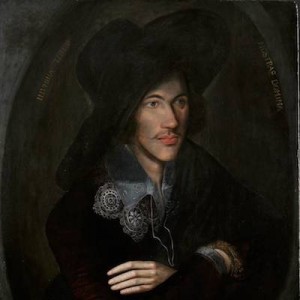Because almost none of Donne’s poetry was published during his lifetime, it is difficult to date it accurately. Most of his poems were preserved in manuscript copies made by and passed among a relatively small but admiring coterie of poetry lovers.
That right there is the Encyclopedia Brittanica telling me to not choose a work by Donne for my project, considering the lack of documented history there is around his poetry. However – he was a well known poet, mostly after his own lifetime – and the first edition of his poetry, “Poems, By J.D. With Elegies on the Authors Death” wasn’t even published until 1633, two years after his death. That makes him and this first edition very interesting.
Biography
John Donne was himself a poet, a preacher, and a lawyer in his lifetime. He wrote some of what is arguably the most poignant and well-crafted poetry in the history of the English language, but he was by (presumably) choice never published in his own lifetime. We talk of him today as one of the finest Metaphysical poets, but his own poetry was mainly circulated in manuscript form, limited to a selective group of admirers.

Donne’s biography locates him in a tumultuous time in British history. Born in 1572, Donne came to the world during the Elizabethan times, which saw an extreme theological struggle for political power via the Church of England. Donne was himself Catholic and therefore a part of the persecuted minority, and while he attended both Oxford and Cambridge he graduated from neither, as that would mean subscribing to the Thirty-Nine Articles, a Protestant doctrine revived when Catholic Elizabeth I succeeded the Protestant Mary I in 1558. As a consequence of the political frame within which he lived, Donne experienced emotional trauma tied to the theological persecutions that ruled Britain at the time. Most importantly, his brother was imprisoned for Catholic sympathies in 1593, and passed away in prison shortly after. This led Donne to question his dedication to own beliefs, and the too powerful friction between the two chapters of Christian faith. During the 1590s he also studied law at Lincoln’s Inn, leaving that for a naval expedition, only to return to Britain a year later to work for Sir Thomas Egerton, Lord Keeper of the Great Seal. Subsequently Donne began to build a political career for himself, which he promptly ruined in 1601 by secretly marrying Egerton’s niece, Anne More. Donne was dismissed and thrown into prison for a short amount of time. After he was released, the couple lived in near poverty while their family rapidly grew, dependant on patrons and charity. Donne himself summed their life up nicely in three short statements: “John Donne, Anne Donne, Undone.” As Donne aged he reunited himself with the Church of England, abandoning his Catholic beliefs. There is some evidence that he around this time wished to put his poetry into print “not much for publique view, but at [his] won cost, a few Copies” (Donne in Keynes 146), but there is no evidence of Donne ever carrying out this intention. He began writing on religion and gained a lot of recognition from the monarchy by writing on overcoming religious differences, although his works are often more critical towards Catholic stragglers who would not give up their faith. Donne later became a preacher, was made the Dean of St. Paul’s Cathedral in London in 1621, and remained a prolific man of faith until his death in 1631.

Donne’s life is thus marked by three distinct periods in his life – the 1590s saw a young ambitious man and womanizer, the early 1600s saw a struggling family-man in love, and post-1610 saw a man rejoined with the Church of England, a preacher, and an author of many incredible sermons. As his life finally began to fall into political and financial place, his wife died in 1617 and Donne was struck with grief. From then until his death in 1631, Donne was, according to his friend and biographer Izaak Walton, “crucified to the world” and wrote no more love poetry. Instead his major work from this time is the very eloquent “Holy Sonnets”, and during the last ten years of his life he wrote incredibly poignant reflections of death, including his own funeral sermon, “Death’s Duel”.
